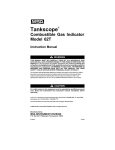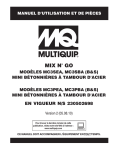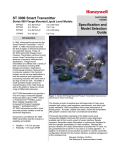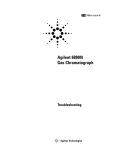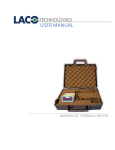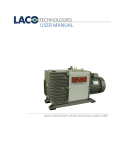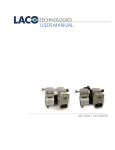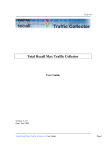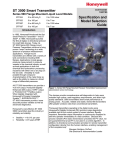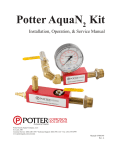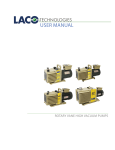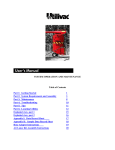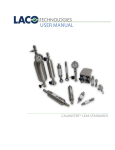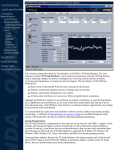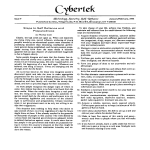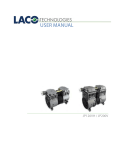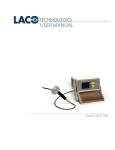Download USER MANUAL - LACO Technologies, Inc.
Transcript
User Manual XRS 9012 Contact Us PHONE/FAX Toll Free: 800.465.1004 Phone: 801.486.1004 Fax: 801.486.1007 ADDRESS LACO Technologies, Inc. 3085 West Directors Row Salt Lake City, UT 84104 WEB www.lacotech.com [email protected] TECHNICAL SUPPORT AND SERVICE [email protected] SMT-07-1022 revA1 Contents 1. SPecifications................................................................1 2. Accessories and parts ..............................................2 3.Theory & Operation.................................................. 3-5 4. application notes.................................................... 6-8 LACO User MANUAL - xrs9012 1. Specifications You know there is a leak, but where? Whether you need to locate a leak in a plant process piping system, or on a production line following leak testing of your part, the XRS9012 is the ideal tool to quickly and accurately pinpoint the leak. The XRS9012 is not affected by humidity or the presence of other gasses and uses inexpensive and abundant forming gas (5% hydrogen, 95% nitrogen), which is also safe and inert. No more depending on expensive and unreliable helium supplies. Simply charge the piping system or production part with the tracer gas mixture and scan for the leak. The XRS9012 has both an LED bar graph indicator as a well as audio feedback to help the operator determine the location of and proximity to the leak. APPLICATIONS Underground: Telephone cables, power cables, gas pipelines, gas stations, heating systems, water pipes. Leaks in buried cables, conduits and pipelines can be difficult to find without the proper tool. The XRS9012 can assist you in quickly locating tiny, underground leaks with the greatest of accuracy, allowing you to effect repairs quickly, and cost-effectively. Leaking tracer gas permeates the surrounding soil and rises to the surface where it is easily detected. Maintenance: The Portable Leak Locator is ideal for determining where you may have a leak in above-ground fluid processing plants. The unit is light and portable and relieves you from being tethered to a cart-mounted workstation. Highly sensitive, the XRS9012 will help you locate leaks down to 1x10-5 atm cc/sec. Post-test leak location on a production line: Keep your production efficiency at maximum by using the XRS9012 to locate the leak for repair after testing a part on a production line. Once a part has failed, remove it to a rework station to locate the leak with the XRS9012, reserving the production leak detector workstation for testing new parts. Features • Portable • High Sensitivity to Find Small Leaks -as small as 1x10-5 atm cc/sec • Highly Selective Hydrogen Sensor - not affected by humidity or other gasses • Sensor at probe tip - faster response time, no maintenance • Heavy Duty, Water Proof Design • Rechargeable Batteries • Includes: Carrying Case, Car Charger, AC Adaptor/Charger • Many Accessories Available XRS9012 Specifications Component Description DIMENSIONS WEIGHT TEMP. RANGE 9.85” x 4.75” x 3.35” (10.25”x8.7”x3.75” in carrying case) Battery info Rechargeable lead batteries (gel electrolyte) 3 hours at 20 °C (68 °F), 6 hours a -20 °C (-4 °F) SENSITIVITY 0.7 ppm H2 in air (<1x10-5 atm cc/sec) outputs 10 LED bar gaph indicator -Speaker -Earphone, standard 3.5 mm (1/8”) jack >8 ohms Warm up time < 6 seconds RESPONSE TIME <1 second Maintenance Maintenance-free chargers AC - (100-240 VAC), Car charger (9-15 VDC) 4.2 lbs (with case 5.5 lbs) -20 °C to +50 °C (-4 ° F to +122 ° F) 1 © 2012 LACO TECHNOLOGIES, INC. LACO User MANUAL - XRS9012 accessories The LACO Portable Leak Locator comes with the hand probe HP-9012, an AC adaptor/charger, a car charger, and earphones along with a soft carrying case that allows it to be slung over your shoulder or belted to your waist to provide you with complete freedom of movement. Hand Probe HP9012 The Hand Probe sensor (included with the XRS9012) is situated at the tip of the probe, providing immediate response. The Hand Probe is an excellent tool for pinpointing leaks. Can also be used with Hand Probe Extension. Surface Probe SP9012 Connects to Portable Leak Locator XRS9012 and allows detection of hydrogen through asphalt and concrete without making barholes through the surface. It has a built-in two speed vacuum pump, dust filter and float valve. Ground Probe GP9012 A practical probe for leak detection in wet or muddy environments, such as soft soil, clay, sand and snow. The sensor is located at the tip and is simply stuck into the ground to detect hydrogen tracer gas escaping from leaks in underground pipes. Hand Probe Extension HPX9012 Extends the reach of the HP9012 Hand Probe. The Hand Probe simply slides in place inside the tubular steel handle and makes walking leak locating so much easier. Gas Fill Kit GFK9012 LACO provides a manifold and regulator with a flow meter and valves that will allow you to connect your bottle of tracer gas and fill the item you want to test. Tracer gas available at national retailers: AirGas p/n-------X02 Ni95C15AJ198 Praxair p/n------ HY Star81-K Open Leak Standard Kit - XRS9012-K LACO’s kit includes the XRS9012, the gas fill kit, the hand probe and the hand Calibrated open leak standards are probe extension assembled together in available for use with your XRS9012 to a hard, protective travel case, or you can enable you to verify that it is working build your own custom kit with just the effectively and that its sensitivity is suitable for your needs. Contact LACO for accessories you need. options and part number. 2 © 2012 LACO TECHNOLOGIES, INC. LACO User MANUAL - xrs9012 This manual is addressed to those responsible for and using the XRS9012 instrument.This leak locator works on the principle of microelectronic sensor technology. The tracer gas does not need to be transported into the locator instrument. Instead there is a small microelectronic chip mounted in a sensor housing, either in a Hand Probe, or in an Insert Probe used in automatic testing equipment. The sensor technology allows a lot of flexibility, which is not the case for traditional leak detectors. The Hydrogen sensor is a unique type of gas sensor, which is very sensitive to Hydrogen and totally insensitive to almost all other substances. While other Hydrogen gas sensors (thermal, catalytic, etc.) used in Hydrogren gas alarm equipment are normallY sensitive to a lot of other gases and vapors, this sensor is not affected by common interferents such as methane, propane, gasoline vapors, water vapors, organic solvent vapors, etc. The sensor consists of an integrated circuit containing a MOS-FET amplifier. Instead of an electrical input to the amplifier there is a thin film of metal hydride, which is permeable to Hydrogen atoms only. Hydrogen molecules (each consisting of two Hydrogen atoms) split into atoms when hitting the metal surface, and are selectively absorbed by the film. The absorbed Hydrogen atoms give rise to a small voltage, which is amplified and transferred to the detector instrument. The instrument carefully controls the temperature of the sensor chip and interprets the sensor signals. The sensor voltage is not a simple function of the gas concentration. Therefore, there is some signal processing in the instrument to compensate for background, drift, etc. and to determine the Hydrogen concentration in a gas sample. Background concentration and interference from other gases limit the sensitivity of gas detectors. Interference is minimal in this case because molecules other than Hydrogen cannot penetrate the metal film, and the background concentration of Hydrogen in air is only 0.5 ppm (parts per million). High amplification together with clever signal processing makes it possible to reliably detect very small leaks of Hydrogen gas. The nature of the MOS-FET (Metal Oxide Sensor - Field Effect Transistor) is that of a very thin piece of metal that is heated when the unit is on. The heated metal allows only Hydrogen molecules to enter but also causes oxidization when Hydrogen is not present. The oxidization will reduce the sensitivity of the sensor over time, but the presence of Hydrogen tends to “clean“ off some of the oxide layer. This is why it is a good idea to give the sensor a strong whiff of the tracer gas at startup, and before turning the unit off. Q&A What is the probe life in hours before replacement is required? The sensor is a consumable and there is no way of telling its life time in hours since the life time is a factor of age, how often it has been used, and how much hydrogen it has been exposed to during usage. Most sensors last longer than two years. The sensor lives longer if it is exposed to good puffs of hydrogen now and then when it is in use (heated). The thing that may shoten life time (except for abuse) is that it is on (heated) for long periods but seldom gets any hydrogen. What is the failure mode of the sensor? Does it just quit working? No. It just slowly becomes more and more insensitive to hydrogen. Users should check the sesnor by either leak locate on the gas bottle/regulator which almost always leaks a bit, or fill the gas line with tracer gas, cuto off the flow, and put the sensor at the end of the gas line. If it reacts but slowly and only at high sensitivity settings, it’s time to replace the sensor. 3 © 2012 LACO TECHNOLOGIES, INC. theory & Operation LACO User MANUAL - XRS9012 Whatis the sign the sensor has begun to fail? Either you get an alarm code on the instrument if the sensor has developed a technical problem (short circuit, can’t be heated or similar - try disconnecting the hand probe when the unit is ON and you will see what happens) or you just notice a decrease in sensitivity when you make a function check against a tracer gas puff. Operation The XRS9012 is a portable, battery-powered instrument for leak detection of hydrogen as part of a mixture of forming gas (5% Hydrogen 95% Nitrogen). The instrument has two operating modes: SEARCH and MAX. The SEARCH mode is used to pinpoint leaks. The pitch of the acoustic signal indicates the concentration of tracer gas around, or in the ground above the cable. The pitch rises as you approach the leak and falls as you move away. Let the sound guide you to the leak. The MAX mode is used to compare the gas concentration in a number of areas, e.g. under manhole covers. This is useful to prelocate leaks after filling a whole length of cable. This applies to pressure routes with air pipes or cables that have no pressure transducers or test valves. Controls on off Sensitivity volume Battery check max zero earphone socket search ON Starts instrument. When the detector is started the ten LEDs light up and subsequently count down during the warm-up sequence. The detector is ready to use when the countdown is completed. OFF Turns instrument off. 4 © 2012 LACO TECHNOLOGIES, INC. SENSITIVITY LACO User MANUAL - xrs9012 The sensitivity of the detector can be set to 10 different levels. The highest levels are extremely sensitive. Conclusions to excavate for the repair of a leak should not normally be made without reconfirming on sensitivity 5 or lower. Use the higher sensitivities for faster identification of suspect areas. Confirm the leak position by measuring more carefully at a lower sensitivity. Wait until the concentraion has increased or make a few holes for higher signals. Excavate only on signals that your can repeat over and over again. The sensitivity is changed by pressing the SENSITIVITY up or down key. Pressing the key momentarily will increase or decrease sensitivity on level and the corresponding LED will light up shortly. The sensitivity will increase/decrease to max or min if the key is held down for longer. NOTE! The sensitivity can not be changed when the instrument is in MAX mode. Switch to SEARCH mode for changing sensitivity. VOLUME + and - set the audio volume. The volume setting changes stepwise to max/min if the key is held down. Volume setting is stored after 1 minute. BATT CHECK show charge status. 10 LEDs indicates fully charged battery (approximately 15 hrs. of operation). LED 1-5 indicates approximately 1 hour of operation/LED. ZERO resets signal to zero. SEARCH sets instrument in SEARCH mode. Auto Power Off The instrument will switch off after 30 minutes if no key is pressed. Battery Protection feature The instrument will automatically switch off in the battery voltage falls below 5.0 V. This protects the battery from harmful deep discharge. max mode testing First, with instrument in SEARCH mode, select appropriate sensitvity level. Place probe at test point and press MAX simultaneously. Leave probe in position. The instrument will now measure for 10 sec. (MAX lamp is blinking) and then indicate the signal strength (MAX mode lamp stays on). Note the reading and proceed to next test point. For a new test, place probe at next point and press MAX simultaneously. To get comparable results it is very important that you place the probe at the test point in exactly the same manner. The MAX mode is primarily intended for Hand Probe HP9012 (under manhole covers) and for Surface Probe SP9012 (on manhole covers and hard toppings). If the selected sensitivity is inappropriate, you must press SEARCH before changing sensitivity. 5 © 2012 LACO TECHNOLOGIES, INC. LACO User MANUAL - XRS9012 Press MAX again to proceed. error codes If an error is detected, the instrument will give off a pulsating acoustic alarm signal and the ON lamp will blink red. The type of error is indicated by the LEDs: LED 1 = Sensor temperature low. LED 2 = Sensor temperature high. LED 3 = Sensor voltage low. LED 4 = Sensor voltage high. LED 8 = Battery voltage <5.0 V. LED 1 and 4 simultaneously, most likely means that either the cable or the probe is not connected. A single LED 1, 2, 3 or 4 most likely means that either the cable or the sensor is broken. LED 8 means the battery needs to be charged. charging The instrument will switch on when charging cable is connected. Charging is fully automatic and ON lamp will blink until battery is fully charged (12 h). Charging voltage is 9 - 15 VDC. Current is limited to 1.5 A maximum. Charging from car battery is possible. 1 hour charging gives 6 hours of operation. 5 minutes gives approx. 20 minutes of operation. For prolonged battery life - charge often and fully! 6 © 2012 LACO TECHNOLOGIES, INC. LACO User MANUAL - xrs9012 Post-test leak location on a production line using the XRS9012 scope This application note explains how to use the LACO Portable Leak Locator to find leaks for post-test leak location on a production line where the part has failed the leak test. BAckground • While Helium is traditionally used as a tracer gas in leak detection and location, it has become difficult to obtain, and expensive to use when, and if, it can be found. Primarily due to helium’s scarcity, alternative methods of leak detection and location have been developed. The XRS9012 uses a tracer gas of H5 (forming gas) which is available everywhere and much less expensive than helium. • This method uses a mixture of 5% Hydrogen/95% Nitrogen, an abundant and inexpensive tracer gas, to fill the TEST item and then locate any leaks with the XRS9012. Although hydrogen exists in the air, there is about 100,000 times more of it by volume in the tracer gas. Notwithstanding this increased presence of hydrogen, the tracer gas is quite safe and not flammable due to the overwhelming amount of nitrogen in the mixture • Unlike other leak location tools, the sensitivity of the XRS9012 is not compromised by humidity. Additionally, the XRS9012 is highly gas specific so the presence of other gasses will not affect the sensor. METHODOLOGY 1. Connect your part to an appropriate manifold and evacuate air from the part 2. Connect your bottle of forming gas to the manifold and fill the part to a safe test pressure. LACO has Hydrogen Charge Systems available to facilitate this process 3. Using the XRS9012, systematically scan the part using the response of the LEDs to determine how close you are to the leak. 4. Continue to test various locations around the spot where you first obtained a signal, to home in on the actual leak location. If the signal maxes out with all LEDs, reduce the sensitivity of the unit and continue to test to determine where the leak is. Vent Test Part Gas Bottle Vacuum Pump (Typical manifold setup) 7 © 2012 LACO TECHNOLOGIES, INC. LACO User MANUAL - XRS9012 Underground leak location using the LACO XRS9012 scope This application note explains how to use the LACO Portable Leak Locator and hydrogen to find leaks in cables, pipes and tanks that are buried underground. BAckground • While Helium is traditionally used as a tracer gas in leak detection and location, it has become difficult to obtain and expensive to use when, and if, it can be found. Primarily due to helium’s scarcity, alternative methods of leak detection and location have been developed. The XRS9012 uses a tracer gas of H5 (forming gas) which is available everywhere and is less expensive than helium. • This method uses a mixture of 5% Hydrogen/95% Nitrogen, an abundant and inexpensive tracer gas, to fill the underground item and then locate any leaks with the XRS9012. Although hydrogen exists in the air, there is about 100,000 times more of it by volume in the tracer gas. Notwithstanding this increased presence of hydrogen, the tracer gas is quite safe and not flammable due to the overwhelming amount of nitrogen in the mixture • It is important to realize that leaking gas will penetrate the surrounding earth through the principle of diffusion rather than buoyancy, so it is necessary to wait a suitable period of time before attempting to locate the leak to allow the tracer gas to make its way to the surface of the ground. If you suspect the leak is not large, it may be necessary to fill your item and wait several hours before testing. • Unlike other leak location tools, the sensitivity of the XRS9012 is not compromised by humidity. Additionally, the XRS9012 is highly gas specific so the presence of other gasses will not affect the sensor. Methodology 1. Verify the location of the underground item. 2. Isolate the underground item into the smallest possible sections for speed and accuracy of testing. 3. If necessary, using compressed air, purge the underground pipe, cable or tank that you want to test. 4. Connect your bottle of forming gas to the underground item with an appropriate manifold and fill it to a low pressure, being careful to never exceed the design pressure of the system. 5. Wait a suitable amount of time for the tracer gas to escape the leak, diffuse through the ground and be detectable. No holes need to be drilled through asphalt or concrete to locate leaks that might be buried, beneath. The porosity of paving materials, and cracks that may exist combined with the extremely small size of a hydrogen molecule, make it possible to detect leaks through these materials. 6. Using the XRS9012, systematically scan the testing area using the response of the LEDs to determine how close you are to the leak. 7. Continue to test various locations around the spot where you first obtained a signal, to home in on the actual leak location. If the signal maxes out with all LEDs, reduce the sensitivity of the unit and continue to test to determine the best place to dig. 8 © 2012 LACO TECHNOLOGIES, INC. LACO User MANUAL - xrs9012 Maintenance leak location using the LACO XRS9012 scope This application note explains how to use the LACO Portable Leak Locator to find leaks in pipes valves and tanks that comprise part of an above ground fluid process system. BAckground • While Helium is traditionally used as a tracer gas in leak detection and location, it has become difficult to obtain and expensive to use when, and if, it can be found. Primarily due to helium’s scarcity, alternative methods of leak detection and location have been developed. The XRS9012 uses a tracer gas of H5 (forming gas) which is available everywhere and is less expensive than helium. • This method uses a mixture of 5% Hydrogen/95% Nitrogen, an abundant and inexpensive tracer gas, to fill the fluid process system and then locate any leaks with the XRS9012. Although hydrogen exists in the air, there is about 100,000 times more of it by volume in the tracer gas. Notwithstanding this increased presence of hydrogen, the tracer gas is quite safe and not flammable due to the overwhelming amount of nitrogen in the mixture. • Unlike other leak location tools, the sensitivity of the XRS9012 is not compromised by humidity. Additionally, the XRS9012 is highly gas specific so the presence of other gasses will not affect the sensor. METHODOLOGY 1. If necessary, using compressed air, purge the fluid process system that you want to test. 2. Isolate the system into the smallest possible sections for speed and accuracy of testing. 3. Connect your bottle of forming gas to one end of a section with an appropriate manifold and fill it to a low pressure, being careful not to exceed the design pressure of the system. 4. Using the XRS9012, systematically scan the testing area using the response of the LEDs to determine how close you are to the leak. 5. Continue to test various locations around the spot where you first obtained a signal, to home in on the actual leak location. If the signal maxes out with all LEDs, reduce the sensitivity of the unit and continue to test to determine where the leak is.. Access point to system Gas Bottle System Under Test Compressed air 9 © 2012 LACO TECHNOLOGIES, INC.












